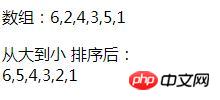 Web Front-end
Web Front-end
 JS Tutorial
JS Tutorial
 Detailed explanation of the sort() method for sorting js arrays (code example)
Detailed explanation of the sort() method for sorting js arrays (code example)
Detailed explanation of the sort() method for sorting js arrays (code example)
How does sort() implement sorting of js arrays? This article will introduce you to the sort() method for sorting js arrays, so that you can understand the principle of sort() in js arrays and how sort() sorts js arrays. It has certain reference value. Friends in need can refer to it. I hope it will be helpful to you.
First of all, let’s take a look at the js sort() method, and look at the sort() sorting method through a simple code example.
sort() method: used to sort the elements of the array; when sorting the array, no new memory is opened, and the original array elements are replaced.
1. The sort() method implements simple sorting of js simple arrays (bubble sorting)
<!DOCTYPE html> <html> <head> <meta charset="UTF-8"> </head> <body> <div> <p>数组:6,2,4,3,5,1</p> <span>排序后:</span> </div> <script type="text/javascript"> var arrSimple = new Array(6,2,4,3,5,1); arrSimple.sort(); document.writeln(arrSimple.join()); </script> </body> </html>
Rendering:

Let’s take a look at the sort() sorting principle:
sort() sorting is a pairwise comparison.
Array: [6,2,4, 3,5,1]
Start of the first round
The first time we compare 6 and 2, 6 is larger than 2, we get 2 and 6, the original array becomes [2,6,4,3, 5,1]
The second time we compare the second and third numbers: 6 and 4, 6 is larger than 4, we get 4 and 6, the result is [2,4,6,3,5,1]
Comparing the third and fourth numbers for the third time: 6 and 3, we get [2,4,3,6,5,1]
Comparing 5 and 6 for the fourth time, the result is [2,4,3,5,6,1]
Comparing 6 and 1 for the fifth time, the result is [2,4,3,5,1,6]
End of the first round
Start of the second round
The first time we compare 2 and 4, 2 is smaller than 4, the result remains the same [2,4,3,5,1,6]
The second time we compare 4 and 3, the result is [2,3,4,5, 1,6]
Compare 4 and 5 for the third time, 4 is smaller than 5, the result remains unchanged [2,3,4,5,1,6]
Compare 5 and 1 for the fourth time, the result is [2 ,3,4,1,5,6]
End of the second round
Start of the third round
Comparing 2 and 3 for the first time, 2 is smaller than 3, the result remains unchanged [2, 3,4,1,5,6]
The second time to compare 3 and 4, 3 is smaller than 4, the result remains unchanged [2,3,4,1,5,6]
The third time to compare 4 and 1, the result is [2,3,1,4,5,6]
End of the third round
Start of the fourth round
Comparing 2 and 3 for the first time, 2 is smaller than 3, The result remains unchanged [2,3,1,4,5,6]
The second time 1 and 3 are compared, the result is [2,1,3,4,5,6]
End of the fourth round
The fifth round begins
The first time 2 and 1 are compared, the result is [1,2,3,4,5,6]
The fifth round ends and the sorting ends.
The result after sorting the array (a total of 15 comparisons were made): [1,2,3,4,5,6]
2, sort() method implementation js Custom sorting of simple arrays
<!DOCTYPE html>
<html>
<head>
<meta charset="UTF-8">
</head>
<body>
<div>
<p>数组:1,8,7,6</p>
<span>从大到小 排序后:</span>
</div>
<script type="text/javascript">
var arrSimple2 = new Array(1, 8, 7, 6);
arrSimple2.sort(function(a, b) {
return b - a;
});
document.writeln(arrSimple2.join());
</script>
</body>
</html>Rendering:

Let’s analyze it:
a, b represents any two elements in the array. If return > 0, the returned value is: b in front and a after (b, a); if reutrn < 0, the returned value is: a B before (a, b); Note: There is browser compatibility when a=b.
To put it simply, the output of a-b is sorted from small to large, and the output of b-a is sorted from large to small.
3. The sort() method implements custom attribute sorting of js simple object arrays (sorted by age attribute)
<!DOCTYPE html>
<html>
<head>
<meta charset="UTF-8">
</head>
<body>
<div>
<p>对象数组:<br><br>
jack,20岁<br>
tony,25岁<br>
stone,26岁<br>
mandy,23岁<br>
</p>
<span>按照年龄排序后:</span>
</div>
<script type="text/javascript">
var objectList = new Array();
function Persion(name,age){
this.name=name;
this.age=age;
}
objectList.push(new Persion('jack',20));
objectList.push(new Persion('tony',25));
objectList.push(new Persion('stone',26));
objectList.push(new Persion('mandy',23));
//按年龄从小到大排序
objectList.sort(function(a,b){
return a.age-b.age});
for(var i=0;i<objectList.length;i++){
document.writeln('<br />'+objectList[i].name+','+objectList[i].age+'岁');
}
</script>
</body>
</html>Rendering:

Summary: The above is the entire content of this article, I hope it will be helpful to everyone's study. For more related tutorials, please visit JavaScript Video Tutorial, jQuery Video Tutorial, bootstrap Tutorial!
The above is the detailed content of Detailed explanation of the sort() method for sorting js arrays (code example). For more information, please follow other related articles on the PHP Chinese website!

Hot AI Tools

Undresser.AI Undress
AI-powered app for creating realistic nude photos

AI Clothes Remover
Online AI tool for removing clothes from photos.

Undress AI Tool
Undress images for free

Clothoff.io
AI clothes remover

Video Face Swap
Swap faces in any video effortlessly with our completely free AI face swap tool!

Hot Article

Hot Tools

Notepad++7.3.1
Easy-to-use and free code editor

SublimeText3 Chinese version
Chinese version, very easy to use

Zend Studio 13.0.1
Powerful PHP integrated development environment

Dreamweaver CS6
Visual web development tools

SublimeText3 Mac version
God-level code editing software (SublimeText3)

Hot Topics
 How to implement an online speech recognition system using WebSocket and JavaScript
Dec 17, 2023 pm 02:54 PM
How to implement an online speech recognition system using WebSocket and JavaScript
Dec 17, 2023 pm 02:54 PM
How to use WebSocket and JavaScript to implement an online speech recognition system Introduction: With the continuous development of technology, speech recognition technology has become an important part of the field of artificial intelligence. The online speech recognition system based on WebSocket and JavaScript has the characteristics of low latency, real-time and cross-platform, and has become a widely used solution. This article will introduce how to use WebSocket and JavaScript to implement an online speech recognition system.
 WebSocket and JavaScript: key technologies for implementing real-time monitoring systems
Dec 17, 2023 pm 05:30 PM
WebSocket and JavaScript: key technologies for implementing real-time monitoring systems
Dec 17, 2023 pm 05:30 PM
WebSocket and JavaScript: Key technologies for realizing real-time monitoring systems Introduction: With the rapid development of Internet technology, real-time monitoring systems have been widely used in various fields. One of the key technologies to achieve real-time monitoring is the combination of WebSocket and JavaScript. This article will introduce the application of WebSocket and JavaScript in real-time monitoring systems, give code examples, and explain their implementation principles in detail. 1. WebSocket technology
 How to use JavaScript and WebSocket to implement a real-time online ordering system
Dec 17, 2023 pm 12:09 PM
How to use JavaScript and WebSocket to implement a real-time online ordering system
Dec 17, 2023 pm 12:09 PM
Introduction to how to use JavaScript and WebSocket to implement a real-time online ordering system: With the popularity of the Internet and the advancement of technology, more and more restaurants have begun to provide online ordering services. In order to implement a real-time online ordering system, we can use JavaScript and WebSocket technology. WebSocket is a full-duplex communication protocol based on the TCP protocol, which can realize real-time two-way communication between the client and the server. In the real-time online ordering system, when the user selects dishes and places an order
 How to implement an online reservation system using WebSocket and JavaScript
Dec 17, 2023 am 09:39 AM
How to implement an online reservation system using WebSocket and JavaScript
Dec 17, 2023 am 09:39 AM
How to use WebSocket and JavaScript to implement an online reservation system. In today's digital era, more and more businesses and services need to provide online reservation functions. It is crucial to implement an efficient and real-time online reservation system. This article will introduce how to use WebSocket and JavaScript to implement an online reservation system, and provide specific code examples. 1. What is WebSocket? WebSocket is a full-duplex method on a single TCP connection.
 Fast array sorting method that preserves key names in PHP
May 02, 2024 pm 03:06 PM
Fast array sorting method that preserves key names in PHP
May 02, 2024 pm 03:06 PM
Fast array sorting method in PHP that preserves key names: Use the ksort() function to sort the keys. Use the uasort() function to sort using a user-defined comparison function. Practical case: To sort an array of user IDs and scores by score while retaining the user ID, you can use the uasort() function and a custom comparison function.
 JavaScript and WebSocket: Building an efficient real-time weather forecasting system
Dec 17, 2023 pm 05:13 PM
JavaScript and WebSocket: Building an efficient real-time weather forecasting system
Dec 17, 2023 pm 05:13 PM
JavaScript and WebSocket: Building an efficient real-time weather forecast system Introduction: Today, the accuracy of weather forecasts is of great significance to daily life and decision-making. As technology develops, we can provide more accurate and reliable weather forecasts by obtaining weather data in real time. In this article, we will learn how to use JavaScript and WebSocket technology to build an efficient real-time weather forecast system. This article will demonstrate the implementation process through specific code examples. We
 Simple JavaScript Tutorial: How to Get HTTP Status Code
Jan 05, 2024 pm 06:08 PM
Simple JavaScript Tutorial: How to Get HTTP Status Code
Jan 05, 2024 pm 06:08 PM
JavaScript tutorial: How to get HTTP status code, specific code examples are required. Preface: In web development, data interaction with the server is often involved. When communicating with the server, we often need to obtain the returned HTTP status code to determine whether the operation is successful, and perform corresponding processing based on different status codes. This article will teach you how to use JavaScript to obtain HTTP status codes and provide some practical code examples. Using XMLHttpRequest
 JS array sorting: in-depth analysis of the working principle and mechanism of the sort() method
Dec 28, 2023 am 11:47 AM
JS array sorting: in-depth analysis of the working principle and mechanism of the sort() method
Dec 28, 2023 am 11:47 AM
To deeply understand JS array sorting: the principles and mechanisms of the sort() method, specific code examples are required. Introduction: Array sorting is one of the very common operations in our daily front-end development work. The array sorting method sort() in JavaScript is one of the most commonly used array sorting methods. However, do you really understand the principles and mechanisms of the sort() method? This article will give you an in-depth understanding of the principles and mechanisms of JS array sorting, and provide specific code examples. 1. Basic usage of sort() method





